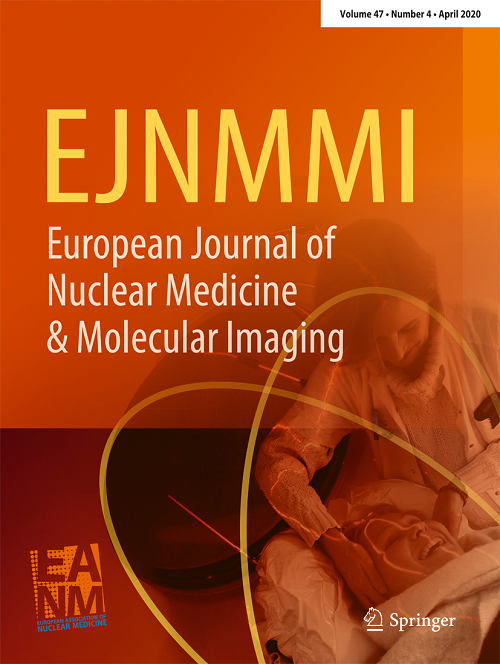Integrated [18F]FAPI-42 PET/MR improves diagnostic accuracy in breast cancer: comparison with simultaneously acquired breast MRI.
IF 7.6
1区 医学
Q1 RADIOLOGY, NUCLEAR MEDICINE & MEDICAL IMAGING
European Journal of Nuclear Medicine and Molecular Imaging
Pub Date : 2025-08-13
DOI:10.1007/s00259-025-07460-3
引用次数: 0
Abstract
PURPOSE This study assessed the diagnostic efficacy of fluorine-18-labeled fibroblast activation protein inhibitor 42 ([18F]FAPI-42) PET/MR versus simultaneously acquired breast MRI in identifying primary breast lesions and axillary lymph node metastases. METHODS A prospective study enrolled 64 women with BI-RADS 4 or 5 lesions identified through mammography or ultrasound. All participants underwent contrast-enhanced [18F]FAPI PET/MRI scans of the breast. Histology and imaging follow-up (median 11.5 months) were used as the gold standard. Primary lesions and lymph nodes were assessed using three imaging modalities: breast MRI, qualitative/quantitative [18F]FAPI PET, and integrated [18F]FAPI PET/MR. Quantitative PET parameters comprised the maximum standardized uptake value (SUVmax) and the tumor-to-background ratio (TBR). Receiver operating characteristic analysis assessed diagnostic performance, while net reclassification improvement (NRI) evaluated the diagnostic enhancement of PET/MR compared to breast MRI. RESULTS The study included 114 breast lesions (89 malignant, 25 benign) and 114 lymph node groups (82 malignant, 32 benign). In detecting primary breast lesions, the quantitative PET/MR based on TBR (PET/MR-TBR) demonstrated superior specificity over breast MRI (96% vs. 68%, P = 0.016), corresponding to a marked reduction in false positive rate from 32% (8/25) to 4.0% (1/25; P = 0.027), while maintaining comparable sensitivity (94% vs. 97%, P = 1.00). For BI-RADS 3/4 lesions on breast MRI, PET/MR-TBR achieved an AUC of 0.90, with a significant NRI of 90.5% (P = 0.018) for BI-RADS 4 lesions. For breast lesions smaller than 10 mm, PET/MR-TBR increased specificity to 94% versus 75% for breast MRI (P > 0.05). For axillary lymph node evaluation, the quantitative PET/MR based on SUVmax (PET/MR-SUVmax) showed improved sensitivity (95% vs. 62%, P < 0.001) and a nonsignificant decrease in specificity (94% vs. 97%, P = 1.00) compared with breast MRI. CONCLUSION [18F]FAPI PET/MR significantly improves diagnostic accuracy over breast MRI, particularly in reducing false positives and improving the detection of axillary lymph node metastases. This modality holds potential for refining breast cancer diagnostics, especially in challenging BI-RADS 4 lesions and improving more accurate staging for smaller lesions.集成[18F]FAPI-42 PET/MR提高乳腺癌诊断准确性:与同时获得性乳腺MRI的比较
目的:本研究评估氟-18标记成纤维细胞活化蛋白抑制剂42 ([18F]FAPI-42) PET/MR与同时获得的乳腺MRI对原发性乳腺病变和腋窝淋巴结转移的诊断效果。方法一项前瞻性研究纳入64名通过乳房x光检查或超声检查发现有4或5个BI-RADS病变的妇女。所有参与者都进行了对比增强[18F]FAPI PET/MRI乳房扫描。以组织学和影像学随访(中位11.5个月)为金标准。使用三种成像方式评估原发性病变和淋巴结:乳房MRI,定性/定量[18F]FAPI PET和综合[18F]FAPI PET/MR。定量PET参数包括最大标准化摄取值(SUVmax)和肿瘤与背景比(TBR)。受试者工作特征分析评估诊断性能,而净重分类改善(NRI)评估PET/MR与乳腺MRI相比的诊断增强。结果共纳入114例乳腺病变(恶性89例,良性25例)和114组淋巴结(恶性82例,良性32例)。在检测乳房原发性病变时,基于TBR的定量PET/MR (PET/MR-TBR)比乳腺MRI显示出更高的特异性(96% vs. 68%, P = 0.016),对应的假阳性率从32%(8/25)显著降低到4.0% (1/25);P = 0.027),同时保持相当的灵敏度(94%对97%,P = 1.00)。对于乳腺MRI上的BI-RADS 3/4病变,PET/MR-TBR的AUC为0.90,BI-RADS 4病变的NRI为90.5% (P = 0.018)。对于小于10mm的乳腺病变,PET/MR-TBR的特异性提高到94%,而乳腺MRI的特异性为75% (P < 0.05)。对于腋窝淋巴结的评估,基于SUVmax的定量PET/MR (PET/MR-SUVmax)与乳腺MRI相比,灵敏度提高(95%对62%,P < 0.001),特异性无显著降低(94%对97%,P = 1.00)。结论[18F]FAPI PET/MR的诊断准确率明显高于乳腺MRI,特别是在减少假阳性和提高腋窝淋巴结转移的检出率方面。这种模式具有改进乳腺癌诊断的潜力,特别是在具有挑战性的BI-RADS 4病变和改善更准确的小病变分期方面。
本文章由计算机程序翻译,如有差异,请以英文原文为准。
求助全文
约1分钟内获得全文
求助全文
来源期刊
CiteScore
15.60
自引率
9.90%
发文量
392
审稿时长
3 months
期刊介绍:
The European Journal of Nuclear Medicine and Molecular Imaging serves as a platform for the exchange of clinical and scientific information within nuclear medicine and related professions. It welcomes international submissions from professionals involved in the functional, metabolic, and molecular investigation of diseases. The journal's coverage spans physics, dosimetry, radiation biology, radiochemistry, and pharmacy, providing high-quality peer review by experts in the field. Known for highly cited and downloaded articles, it ensures global visibility for research work and is part of the EJNMMI journal family.

 求助内容:
求助内容: 应助结果提醒方式:
应助结果提醒方式:


